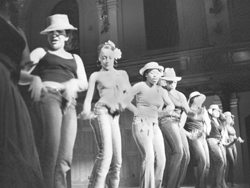Colors
of Rhythm Creates Solidarity Among Obies
by Patricia Ngnoumen
 On
an unusually warm evening last night, a group of Obies gathered
in Finney chapel to attend the sixth annual performance of Colors
of Rhythm. The much-anticipated multicultural performance Colors
of Rhythm offered a place for artists of color to express themselves
freely and to honor their distinguished heritage. The goal of Colors
of Rhythm is not only to provide a performance space, but also to
build and reinforce coalitions amongst students of multicultural
backgrounds. On
an unusually warm evening last night, a group of Obies gathered
in Finney chapel to attend the sixth annual performance of Colors
of Rhythm. The much-anticipated multicultural performance Colors
of Rhythm offered a place for artists of color to express themselves
freely and to honor their distinguished heritage. The goal of Colors
of Rhythm is not only to provide a performance space, but also to
build and reinforce coalitions amongst students of multicultural
backgrounds.
Created by students of color for students of color, Colors of Rhythm
was born six years ago in an attempt to support and represent non-Western
dance and art forms. “As a performer, I feel as if it was nice
to see people of color group together and have fun, share that kind
of energy. It’ll be nice to be on the front of the web page
this year. And hopefully, next year we’ll get a real tech week
space,” junior Chimyelu Ndubisi said.
The show consisted of a series of nine eclectic performances. The
evening started off with a piece entitled “POC solidarity.”
Here, a group of Oberlin students came together in solidarity to
embrace their differences and struggles. Many in the audience were
mesmerized by the their captivating talent and enthusiasm.
“I thought it was beautiful to see brown people being honest
with themselves and with the audience. There was great dialogue
between the performers and us. They communicated with us really
well,” first-year Ronni Armtead said.
The next two performances were both meaningful and satisfying. The
second act, “Waves,” was a dance interpretation of migratory
patterns of immigrants within the Philippine Islands. The performers
in the following piece, “Sancocho,” invited the audience
to join them as they salsa danced to fiery beats from the Caribbean
and Latin America.
“The show was well-organized. There were a lot of different
mixes — I like variety,” senior Josephine Lukoma said.
In “Shristi Shukher Ullashey,” performers Shahriar Kabir,
Mujaddid Mohsin and Dwaipayan “Buro” Sen recited a poem
written by the national poet of Bangladesh, Kasi Nazrul Islam, while
dancer Shahana Siddiqui moved to a visual interpretation dealing
with those who died in the Bengali language struggle of 1952.
“The show was good — it showed a good range of performances.
Menna and Aaliyah were admirable. It was just a good mix,”
senior Malaika Jeter said. Performers Aaliyah Bilal and Menna Demessie
fascinated those in attendance with a piece that portrayed the traditional
dances of Ethiopia. Called the “scista,” it is an energetic
dance with intense shaking of the shoulders.
“Another thing that I really liked was the fact that the pieces
embraced differences. Some of the pieces incorporated different
styles in one dance. This is symbolic — we need to work on
embracing our differences,” senior Natalie Wills said. An example
of such a piece is “Hip Hop Mix: Shake it Up,” a combination
of modern hip-hop (including the “Harlem Shake” and the
“scista”). The performers of this dance portrayed the
connections between all peoples of African descent.
After the intermission, the audience was offered a chance to participate
in “Salsa 101,” as a dance dialogue fashioned by Jorge
Sanchez and Katherine Fernandez. Next, was the sizzling performance
“Force De Frappe” (French for “the strength of power”).
This dance style, called “Shaku-Libondance,” comes from
the Democratic Republique of the Congo, and requires a sensual rotation
of the hip.
“It was nice to have our voices heard,” dancer and junior
Taye Amegboh said.
I am fascinated by how the energy of the performers and supporters
of Colors of Rhythm has been maintained through the last years,”
Oberlin College alum Erika Englund remarked. The last piece was
indeed a magnificent way to end the evening.
“Guantanamera” reflected the diversity of the experience
of Latinos in the Unites States. By incorporating a mixture of traditional
song and spoken words, the vocalists spoke about resistance —
the resistance that is shared by many amongst communities of color
in and around the Americas.
|



